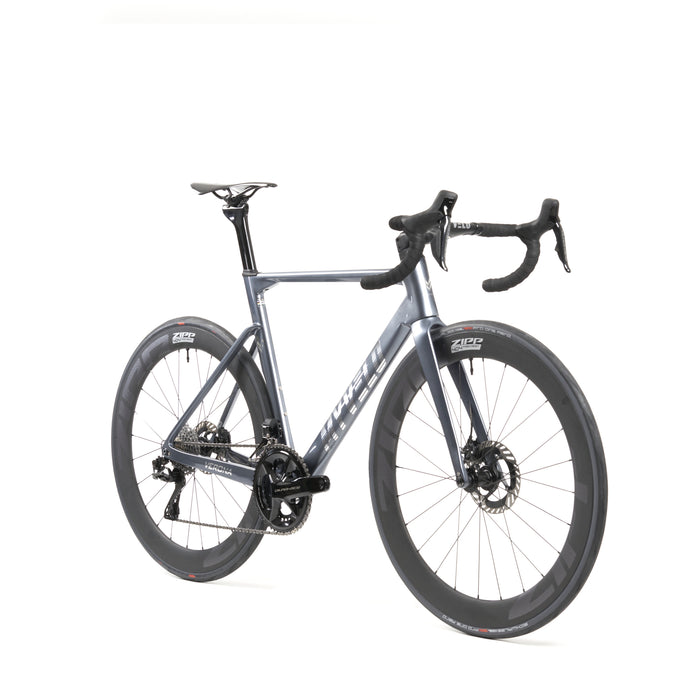
Verona road bike
incl. FREE shipping & free returns

What if you could achieve noticeable progress on your road bike with just a few minutes per week? It sounds too good to be true – but it's scientifically proven. The magic word: all-out training. This form of training is based on extremely short, yet maximally intense bursts of exercise and pushes your body to its limits. In this article, you'll learn what "all-out" really means, how it works, and how you can incorporate it into your road bike training.
Von Vincent Augustin |
3 minutes read time

"All-out" stands for maximum physical performance – without holding back, without pacing. It's about giving everything you can at that moment. Unlike classic intervals , where the pace is controlled and maintained for several minutes, the focus of all-out units is on short, explosive bursts. A typical example: a 20-second sprint at 100% effort – followed by several minutes of rest.
All-out training primarily focuses on anaerobic energy production, i.e., energy utilization without oxygen. In the first few seconds, the body draws on its creatine phosphate reserves, after which lactate production begins. The high stimulus leads to adaptations on several levels:
Increase in VO₂max (maximum oxygen uptake capacity)
Improvement of neuromuscular control
Increased lactate tolerance
Improve explosive power
These adjustments not only make you faster in sprints, but also more efficient over long distances.
There are different types of all-out training that differ in duration, goal and intensity:
Example: 6×20 seconds all-out with 4 minutes break
→ Focus: Explosiveness & neuromuscular performance
Example: 8×20 seconds all-out / 10 seconds rest
→ Focus: anaerobic capacity & maximum load in the shortest possible time
30 seconds all-out on an ergometer or Wattbike
→ Focus: anaerobic power & mental resilience
10 seconds all-out from a standstill, directly after a relaxed ride
→ Focus: Starting power & maximum wattage
Important: Before each all-out interval, a thorough warm-up is crucial to avoid injuries.
Despite the short time investment, all-out training has surprisingly large effects:
🚀 Time efficient: 10 minutes of training can be enough
💥 Strong training stimulus for the cardiovascular and muscular systems
🧠 Mental strength: Those who regularly go all-out become more resilient
⛰️ More speed endurance: Especially noticeable during sprints, attacks & short climbs
Studies show that short, intensive sessions can even have comparable effects to long basic sessions – but with significantly more intensity.
Where there's a lot of impact, there's also a lot of stress. All-out training isn't a daily routine and, if used incorrectly, can do more harm than good:
❌ Overload of the central nervous system
❌ Increased risk of injury due to insufficient warm-up
❌ Not suitable for beginners or people with heart problems
Therefore, do not exercise more than 1-2 times a week – and only during a period of good recovery and stability.
All-out training is particularly suitable for:
Ambitious amateur athletes
Competition-oriented drivers
Cyclists with little time who still want to progress
Advanced runners who want to improve their VO₂max and sprint power
All-out is not suitable for absolute beginners – here the focus should be on basic and threshold training.
This is how all-out can be implemented effectively:
📅 Example week:
| day | Unit |
|---|---|
| Monday | Rest day or relaxed GA1 ride |
| Tuesday | All-out interval training (e.g. 6×20 s) |
| Wednesday | Relaxed basic training |
| Thursday | Threshold training or sweet spot |
| Friday | Rest day |
| Saturday | Longer exit |
| Sunday | Paddock day: fartlek or technique |
Tip: All-out also works great in winter on the roller trainer – especially with tools like Zwift or Rouvy.
All-out is often confused with High Intensity Interval Training (HIIT) – but there are differences:
| feature | HIIT | All-out |
|---|---|---|
| Intensity | Submaximal (~90%) | Maximum (100%) |
| Length of time | 30 sec. – 4 min. | 10 – 30 sec. |
| Recovery time | Shorter | Significantly longer |
| Target group | Wider | Advanced |
Conclusion: All-out is the radical sister of HIIT – highly efficient, but only suitable for certain training goals and athletes.
All-out training isn't a miracle cure — but it's an extremely effective tool in the arsenal of ambitious road cyclists. It requires courage, discipline, and a good sense of your own body. When used correctly, it can help you deliver maximum stimulus in the shortest possible time and take your performance to a new level.
Train smart – not just hard. And when you train hard, go all out sometimes.